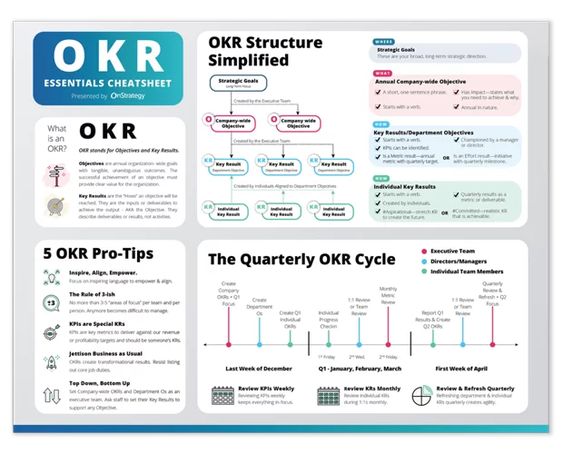What are OKRs?
OKRs, or Objectives and Key Results, is a goal-setting framework used by organizations to align and track their progress towards specific and measurable objectives. The framework was first popularized by Intel in the late 1990s and has since been adopted by many companies, including Google, as a way to set, track, and achieve their goals.
Step by Step Guide to Implementing OKRs
- Define your Objectives: The first step in implementing OKRs is to define your objectives. Objectives should be specific, measurable, attainable, relevant, and time-bound (SMART). This means that your objectives should be clear and unambiguous, have a specific target, be achievable, align with your overall strategy, and have a defined timeline.
- Identify Key Results: Once you have defined your objectives, the next step is to identify the key results that will help you measure your progress towards achieving those objectives. Key results should be quantifiable and trackable, and they should be tied directly to your objectives.
- Align Objectives Across the Organization: To ensure that everyone is working towards the same goals, it’s important to align your OKRs across the entire organization. This means involving all relevant stakeholders in the process and ensuring that their objectives align with the overall strategy.
- Set Priorities: With your objectives and key results defined, the next step is to set priorities. This means deciding which objectives and key results are most important and should be given the most attention.
- Establish a Regular Review Process: To ensure that your OKRs remain relevant and effective, it’s important to establish a regular review process. This could be done weekly, monthly, or quarterly, depending on your organization’s needs. During these reviews, you should assess your progress towards your objectives, make any necessary adjustments, and set new key results as needed.
- Communicate Progress: Finally, it’s important to communicate your progress towards your OKRs to all relevant stakeholders. This will help keep everyone informed and motivated, and it will also help ensure that everyone is working towards the same goals.
You might find these FREE courses useful
Conclusion
OKRs can be a powerful tool for organizations looking to align and track their progress towards specific, measurable objectives. By following these six steps, you can successfully implement OKRs in your organization and start seeing the benefits in no time.


